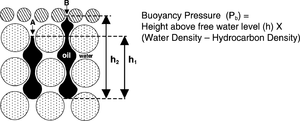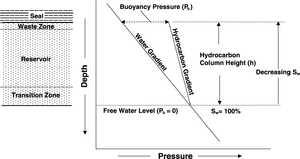Difference between revisions of "Hydrocarbon expulsion, migration, and accumulation"
Cwhitehurst (talk | contribs) |
|||
| Line 21: | Line 21: | ||
==Migration== | ==Migration== | ||
| − | [[file:predicting-reservoir-system-quality-and-performance_fig9-14.png|thumb|{{figure number|1}}After | + | [[file:predicting-reservoir-system-quality-and-performance_fig9-14.png|thumb|{{figure number|1}}After <ref name=ch09r6>Berg, R., 1975, [http://archives.datapages.com/data/bulletns/1974-76/data/pg/0059/0006/0900/0939.htm Capillary pressures in stratigraphic traps]: AAPG Bulletin, vol. 59, no. 6, p. 939–956.</ref>.]] |
Hydrocarbon migrates through an aquifer when it is “buoyed” upward due to AP caused by the density differential of the hydrocarbons and the formation water. The oil or gas migrates in filaments through the pore system of the aquifer as long as the [[buoyancy pressure]] (P<sub>b</sub>) exceeds the capillary resistance of the water in the pore throats. This relationship is illustrated in the diagram below. | Hydrocarbon migrates through an aquifer when it is “buoyed” upward due to AP caused by the density differential of the hydrocarbons and the formation water. The oil or gas migrates in filaments through the pore system of the aquifer as long as the [[buoyancy pressure]] (P<sub>b</sub>) exceeds the capillary resistance of the water in the pore throats. This relationship is illustrated in the diagram below. | ||
Revision as of 22:42, 10 March 2014
| Exploring for Oil and Gas Traps | |

| |
| Series | Treatise in Petroleum Geology |
|---|---|
| Part | Predicting the occurrence of oil and gas traps |
| Chapter | Predicting reservoir system quality and performance |
| Author | Dan J. Hartmann, Edward A. Beaumont |
| Link | Web page |
| Store | AAPG Store |
The pores and fluids of a reservoir system interact during the processes of expulsion, migration, accumulation, and flow to a wellbore. Differential pressure (ΔP) in the fluid continuum of the petroleum system, caused by properties of fluids and pores, controls these processes.
Expulsion
Hydrocarbon generation causes pressure build-up in the source rock, exceeding the pore pressure of the adjacent aquifer. Oil or gas is expelled or “squeezed” into the aquifer due to the differential pressures between source rock and aquifer fluid.
Migration

Hydrocarbon migrates through an aquifer when it is “buoyed” upward due to AP caused by the density differential of the hydrocarbons and the formation water. The oil or gas migrates in filaments through the pore system of the aquifer as long as the buoyancy pressure (Pb) exceeds the capillary resistance of the water in the pore throats. This relationship is illustrated in the diagram below.
For migration to continue as pore throat size decreases from one site to the next (points A and B in Figure 1), the length of the filament (h) must increase until an adequate Pb exists across the pore throat to initiate breakthrough.
Accumulation
A hydrocarbon accumulation forms when migrating hydrocarbon filaments encounter a zone (the seal), either laterally or vertically, with pore throat sizes smaller than the carrier bed. The seal pore throat breakthrough pressure or the distance to the spill point of the trap, whichever is less, determines the hydrocarbon accumulation column height.
Buoyancy pressure profile
When a reservoir has formed in a trap and has come to pressure equilibrium with the water in the aquifer, the pore pressure of the hydrocarbons at different depths in the reservoir plot along a steeper gradient than the water gradient. Figure 2 shows this relationship.
The pressure contrast between the hydrocarbon gradient and the water gradient at a given depth in the reservoir (height above free water) is the buoyancy pressure (Pb). The longer the column, the higher the Pb at the top of the column.
Water saturation
The water remaining on the surfaces of the pores and pore throats of a rock after hydrocarbon has driven (drained) out the rest of the water is called the residual water saturation (Swr). Pb provides the energy needed to overcome the capillary resistance of the water in the pore throat and drive down Swr in the pore. The higher a portion of the reservoir (with a given capillary pressure profile-pore type) occurs above the zero pressure::(0 psi) Pb position, the lower its Swr will become. Consequently, an Swr model can be developed from capillary pressure profiles because Swr is a function of the profile of pore throat sizes and height above Pb = pressure::0 psi.
See also
- Pore–fluid interaction
- Characterizing rock quality
- Pc curves and saturation profiles
- Converting Pc curves to buoyancy, height, and pore throat radius
- What is permeability?
- Relative permeability and pore type
References
- ↑ Berg, R., 1975, Capillary pressures in stratigraphic traps: AAPG Bulletin, vol. 59, no. 6, p. 939–956.
